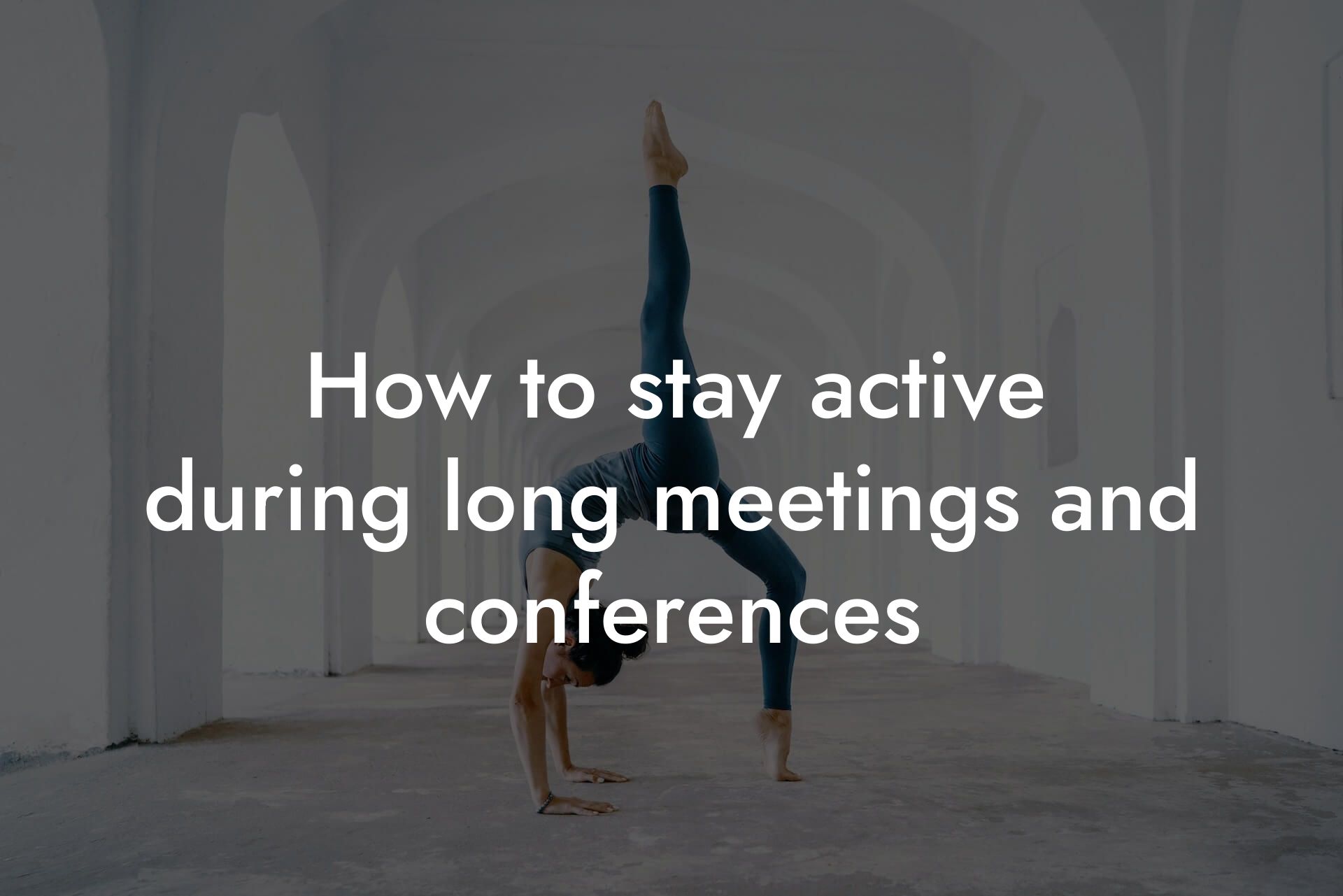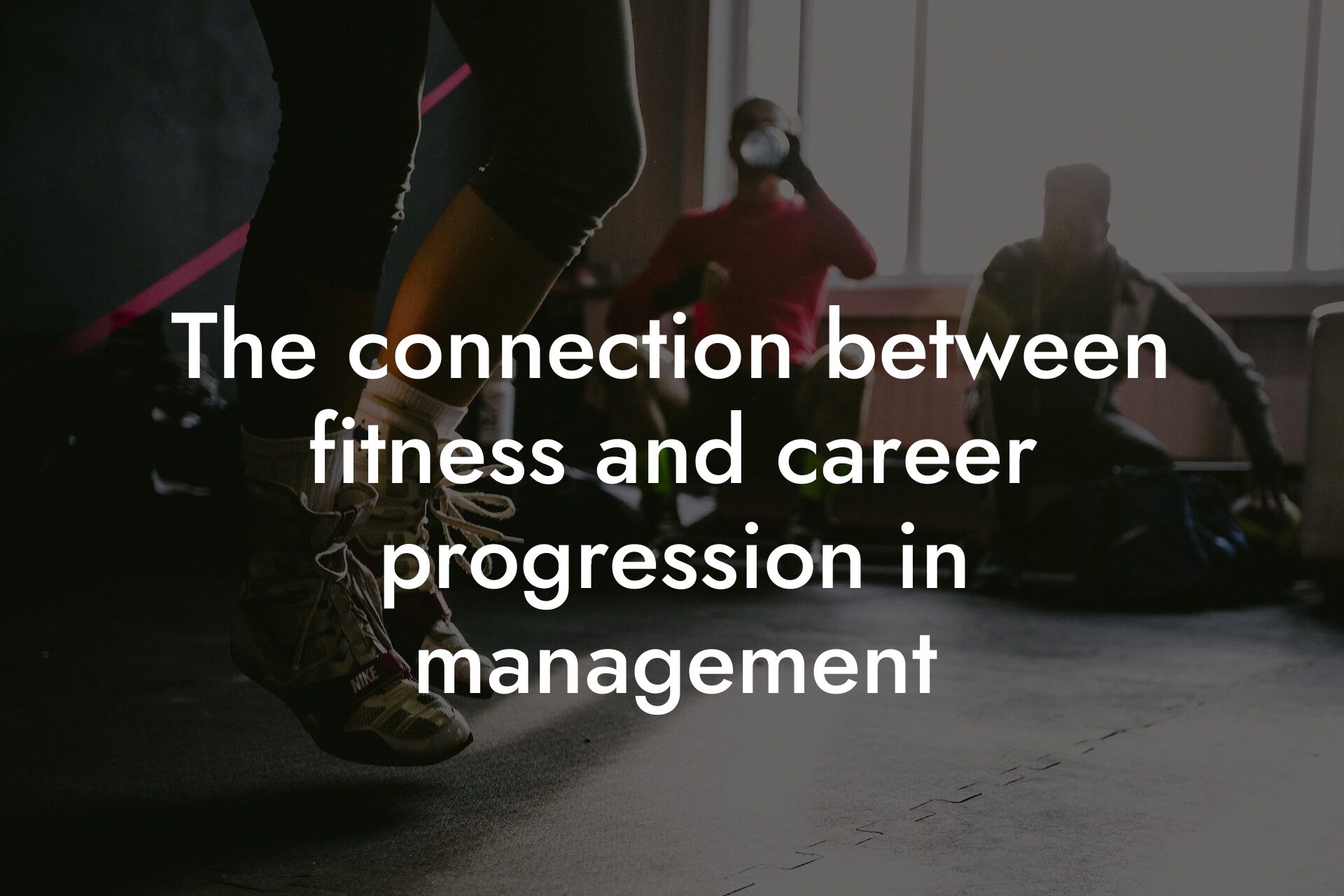As a high-earning professional, you understand the importance of setting a good example for your team and colleagues. One way to do this is by prioritizing your physical fitness. When you take care of your body, you're not only improving your overall health and well-being, but you're also demonstrating to others that you're committed to excellence in all areas of your life. In this article, we'll explore the benefits of leading by example with physical fitness and provide you with practical tips on how to do it.
Table of Contents
Why Physical Fitness Matters for Leaders
As a leader, you're constantly being watched and emulated by your team. When you prioritize your physical fitness, you're sending a powerful message that you value hard work, discipline, and self-care. This can have a profound impact on your team's morale and productivity. When you're physically fit, you're more energized, focused, and motivated, which can inspire your team to do the same.
Fitness also plays a critical role in reducing stress and anxiety, which are common pitfalls for high-achievers. By prioritizing physical fitness, you're showing your team that you're proactive about managing stress and taking care of your mental health. This can help create a more positive and supportive work environment.
The Benefits of Leading by Example
Leading by example with physical fitness can have a range of benefits for you and your team. Some of the most significant advantages include:
• Increased credibility: When you prioritize your physical fitness, you're demonstrating to your team that you're committed to excellence in all areas of your life. This can increase your credibility and authority as a leader.
• Improved team morale: When you lead by example with physical fitness, you're showing your team that you care about their well-being and are invested in their success. This can boost team morale and motivation.
• Enhanced productivity: Physical fitness can improve your focus, energy, and motivation, which can have a direct impact on your productivity and performance. When you lead by example, you're encouraging your team to do the same.
• Better work-life balance: Prioritizing physical fitness can help you achieve a better balance between your work and personal life. This can lead to increased job satisfaction and reduced burnout.
Setting Fitness Goals as a Leader
As a leader, it's essential to set fitness goals that are specific, measurable, achievable, relevant, and time-bound (SMART). This will help you stay focused and motivated, and provide a clear direction for your team to follow.
Some examples of SMART fitness goals might include:
• Running a certain number of miles per week
• Completing a certain number of workouts per month
• Reducing body fat percentage by a certain amount
• Increasing bone density through regular exercise and nutrition
Creating a Fitness Routine as a Busy Professional
As a high-earning professional, you're likely to have a demanding schedule that makes it challenging to prioritize physical fitness. However, with a little creativity and planning, you can create a fitness routine that works for you.
Some tips for creating a fitness routine as a busy professional include:
• Scheduling workouts into your calendar and treating them as non-negotiable appointments
• Finding a workout buddy or accountability partner to keep you motivated
• Incorporating high-intensity interval training (HIIT) workouts that can be completed in under 30 minutes
• Using a fitness tracker or app to monitor your progress and stay on track
Using DEXA Scans to Track Progress
As a leader, it's essential to track your progress and stay accountable to your fitness goals. One way to do this is by using DEXA scans, which provide a comprehensive assessment of your body composition, including body fat percentage, bone density, and lean muscle mass.
DEXA scans can help you:
• Identify areas for improvement and track progress over time
• Develop a personalized fitness plan that targets specific areas of your body
• Stay motivated and accountable to your fitness goals
At Tano Performance Group, we offer DEXA scans as part of our comprehensive body assessment package. This can provide you with a detailed understanding of your body composition and help you develop a fitness plan that's tailored to your needs and goals.
Leading by Example in the Workplace
As a leader, it's essential to lead by example in the workplace by promoting a culture of physical fitness and wellness. This can be done by:
• Encouraging team members to prioritize their physical fitness and providing resources to support them
• Leading by example by prioritizing your own physical fitness and sharing your experiences with your team
• Creating a supportive and inclusive work environment that promotes physical activity and wellness
• Providing incentives or rewards for team members who prioritize their physical fitness and achieve their goals
Overcoming Common Obstacles
As a leader, you may face a range of obstacles that can make it challenging to prioritize physical fitness. Some common obstacles include:
• Lack of time or energy
• Fear of failure or embarrassment
• Difficulty staying motivated or accountable
• Limited access to fitness resources or facilities
To overcome these obstacles, it's essential to:
• Start small and set achievable goals
• Find a workout buddy or accountability partner
• Celebrate small victories and milestones
• Seek out fitness resources and facilities that work for you
Leading by example with physical fitness is a powerful way to demonstrate your commitment to excellence and inspire your team to do the same. By prioritizing your physical fitness, you're showing your team that you value hard work, discipline, and self-care. This can have a profound impact on your team's morale and productivity, and can help create a more positive and supportive work environment.
Remember to set SMART fitness goals, create a fitness routine that works for you, and use DEXA scans to track your progress. By leading by example with physical fitness, you can take your business to the next level and achieve greater success and fulfillment in your personal and professional life.
Frequently Asked Questions
What does it mean to lead by example with physical fitness?
Leading by example with physical fitness means setting a positive tone and inspiring others to adopt healthy habits by showcasing your own commitment to fitness. As a high-earning professional, you have the opportunity to influence those around you, including colleagues, friends, and family members, by demonstrating the importance of physical fitness in your daily life.
Why is physical fitness important for high-earning professionals?
Physical fitness is crucial for high-earning professionals because it helps to increase energy levels, improve mental clarity, and reduce stress. As a professional, you require a high level of physical and mental stamina to perform at your best, and regular exercise can help you achieve that. Additionally, physical fitness can also boost your confidence, enhance your overall well-being, and even improve your professional reputation.
How can I prioritize physical fitness in my busy schedule?
Prioritizing physical fitness in your busy schedule requires commitment and creativity. Start by scheduling your workouts in your calendar, just as you would any other important appointment. Find exercises that can be done in short intervals, such as high-intensity interval training (HIIT) or bodyweight exercises, and aim to do at least 30 minutes of moderate-intensity exercise per day. You can also incorporate physical activity into your daily routine, such as taking the stairs instead of the elevator or going for a walk during your lunch break.
What are some simple exercises I can do at my desk?
There are several simple exercises you can do at your desk to stay active and focused throughout the day. These include chair squats, desk push-ups, leg raises, and wrist extensions. You can also try taking a few minutes to stretch, whether it's stretching your arms over your head, rolling your shoulders, or stretching your neck and back.
How can I stay motivated to exercise regularly?
Staying motivated to exercise regularly requires setting specific, achievable goals and finding an exercise routine that you enjoy. Vary your workouts to avoid boredom, and consider finding a workout buddy or personal trainer to hold you accountable. Reward yourself for reaching your fitness milestones, and don't be too hard on yourself if you miss a workout – simply get back on track as soon as possible.
What are some healthy snacks I can keep at my desk?
Keeping healthy snacks at your desk can help curb cravings and provide a quick energy boost. Some healthy snack options include nuts, seeds, dried fruits, energy bars, and jerky. You can also consider keeping a small fridge at your desk to store fresh fruits, vegetables, and cheese.
How can I make healthy meal prep a part of my busy schedule?
Making healthy meal prep a part of your busy schedule requires some planning and preparation. Start by planning your meals for the week, making a grocery list, and shopping for healthy ingredients. Set aside one day a week to prep your meals, and consider using a slow cooker or instant pot to make healthy meals quick and easy.
What are some benefits of having a workout buddy?
Having a workout buddy can provide accountability, motivation, and social support. Exercising with a buddy can also make the experience more enjoyable, help you try new exercises, and provide an opportunity to learn from each other's strengths and weaknesses.
How can I track my progress and stay accountable?
Tracking your progress and staying accountable requires setting specific, measurable goals and finding a system that works for you. Consider using a fitness tracker, mobile app, or spreadsheet to track your workouts, weight, and body fat percentage. Share your goals and progress with a friend or workout buddy to provide an added level of accountability.
What are some common mistakes people make when trying to lead by example with physical fitness?
Some common mistakes people make when trying to lead by example with physical fitness include being too hard on themselves, trying to make drastic changes too quickly, and not being consistent. It's also important to avoid comparing yourself to others and instead focus on your own progress and goals.
How can I balance my fitness goals with my professional responsibilities?
Balancing your fitness goals with your professional responsibilities requires prioritization, time management, and creativity. Consider scheduling your workouts during your lunch break or early in the morning, and find exercises that can be done in short intervals. Don't be afraid to take breaks throughout the day to stretch and move, and remember that taking care of your physical health can actually improve your professional performance.
What are some tips for staying hydrated throughout the day?
Staying hydrated throughout the day requires drinking plenty of water, avoiding sugary drinks, and eating hydrating foods. Aim to drink at least eight glasses of water per day, and consider keeping a water bottle at your desk to remind you to drink regularly. You can also infuse your water with fruits or herbs for added flavor.
How can I make physical fitness a part of my company culture?
Making physical fitness a part of your company culture requires leadership buy-in, employee engagement, and creative programming. Consider offering fitness classes, workout challenges, or wellness workshops, and provide incentives for employees who participate. You can also create a wellness committee to oversee fitness initiatives and provide ongoing support.
What are some benefits of incorporating physical fitness into my daily routine?
Incorporating physical fitness into your daily routine can provide numerous benefits, including increased energy, improved mental clarity, and enhanced overall well-being. Regular exercise can also reduce stress, improve sleep, and boost your immune system. Additionally, physical fitness can increase your confidence, enhance your professional reputation, and even improve your relationships with colleagues and friends.
How can I stay active during the winter months?
Staying active during the winter months requires creativity and flexibility. Consider finding indoor workout options, such as yoga classes, swimming, or indoor cycling. You can also invest in home workout equipment, such as a treadmill or stationary bike, or try bodyweight exercises that can be done in the comfort of your own home.
What are some tips for exercising safely and avoiding injury?
Exercising safely and avoiding injury requires listening to your body, starting slowly, and warming up properly. It's also important to cool down after your workout, stretch regularly, and incorporate rest days into your routine. Consider working with a personal trainer or fitness coach to develop a customized workout plan that meets your needs and goals.
How can I make physical fitness a family affair?
Making physical fitness a family affair requires finding activities that everyone can enjoy, setting a positive example, and making it fun. Consider trying new sports or activities together, such as hiking, biking, or swimming. You can also create a family fitness challenge or set up a reward system to encourage everyone to stay active.
What are some benefits of incorporating strength training into my workout routine?
Incorporating strength training into your workout routine can provide numerous benefits, including increased muscle mass, improved bone density, and enhanced overall strength. Strength training can also improve your metabolism, reduce your risk of injury, and boost your confidence.
How can I stay motivated during a plateau?
Staying motivated during a plateau requires reassessing your goals, trying new exercises, and finding a workout buddy or accountability partner. Consider setting new, challenging goals, and reward yourself for small victories. Don't be too hard on yourself, and remember that plateaus are a normal part of the fitness journey.
What are some tips for getting started with a new exercise routine?
Getting started with a new exercise routine requires setting specific, achievable goals, finding an exercise routine that you enjoy, and starting slowly. It's also important to listen to your body, warm up properly, and cool down after your workout. Consider working with a personal trainer or fitness coach to develop a customized workout plan that meets your needs and goals.
How can I make physical fitness a part of my long-term goals?
Making physical fitness a part of your long-term goals requires setting specific, measurable objectives, finding a workout routine that you enjoy, and making it a priority. Consider setting fitness milestones, such as running a marathon or completing a triathlon, and create a plan to achieve them. Remember to stay flexible, and don't be afraid to adjust your goals as needed.
What are some benefits of incorporating flexibility exercises into my workout routine?
Incorporating flexibility exercises into your workout routine can provide numerous benefits, including improved range of motion, reduced muscle soreness, and enhanced overall flexibility. Flexibility exercises can also improve your posture, reduce your risk of injury, and boost your athletic performance.
How can I stay accountable and motivated on my fitness journey?
Staying accountable and motivated on your fitness journey requires setting specific, measurable goals, finding a workout buddy or accountability partner, and tracking your progress. Consider sharing your goals and progress on social media, working with a personal trainer or fitness coach, and rewarding yourself for small victories. Remember to stay positive, and don't be too hard on yourself.
Here are some related articles you might love...
- Strategies for maintaining fitness during corporate travel
- How to stay active during long meetings and conferences
- The connection between fitness and career progression in management
- Nutrition tips for staying sharp in the corporate world
- The impact of body composition on team leadership
- How DEXA scans can help managers optimize their health
- The importance of physical health in effective management
- Balancing work and fitness: Tips for corporate leaders
- How corporate managers can incorporate fitness into their daily routines
Zak Faulkner
Zak Faulkner is a leading authority in the realm of physical health and body composition analysis, with over 15 years of experience helping professionals optimise their fitness and well-being. As one the experts behind Tano Performance Group, Zak has dedicated his career to providing in-depth, science-backed insights that empower clients to elevate their physical performance and overall health.
With extensive knowledge of DEXA technology, Zak specializes in delivering comprehensive body assessments that offer precise data on body fat, muscle mass, bone density, and overall physique. His expertise enables individuals to make informed decisions and achieve their fitness goals with accuracy and confidence. Zak’s approach is rooted in a deep understanding of human physiology, combined with a passion for helping clients unlock their full potential through personalised strategies.
Over the years, Zak has earned a reputation for his commitment to excellence, precision, and client-focused service. His guidance is trusted by top professionals who demand the best when it comes to their health. Whether advising on fitness programs, nutritional strategies, or long-term wellness plans, Zak Faulkner’s insights are a valuable resource for anyone serious about taking their health and fitness to the next level.
At Tano Performance Group, Zak continues to lead our Content Team revolutionising how professionals approach their physical health, offering unparalleled expertise that drives real results.




